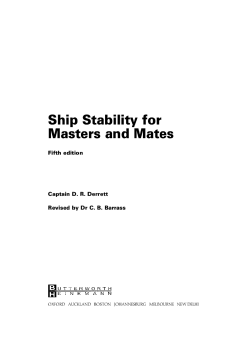
Additional Information
Book Details
Abstract
This well-established textbook has been fully reviewed and updated by a new author to ensure a modern coverage of the contents in depth. A new unique introduction has been written, giving ship types together with their general characteristics, to indicate to the reader actual or typical sizes of modern day merchant vessels.
Four new chapters have been added dealing with Ship Squat, the Deadweight scale, Interaction and The Trim and Stability book. A new section, on Draft Surveys, is included in the Appendices. In order to give the student a better understanding of ship strength, four smaller but more detailed chapters replace the chapter covering this subject area in the previous edition.
Ship Stability, with respect to motions, can be defined as the ability of a ship to return to an initial condition after she has been subjected to disturbing forces and moments. Ship Stability can also exist with respect to materials stresses and forces, where it is the ability to return to an initial state after being subjected to external or internal forces. Careful attention has been paid to the basic principles of ship stability and ship strength. Included is a generous provision of worked examples and exercise questions with answers. These ensure that the maritime student who works through this book will have a clear grasp of the topics covered. Up-to-date syllabuses and recent examination papers are included at the end of this book.
"A thorough textbook that delves into the many intricacies of ship stability. Great for students, engineers, or as a shipboard reference. Topics include: forces and moments, laws of flotation, displacement curves, trim, water pressure, ship squat, drydocking, and more." Offshore Engineer
"I found this a useful reference book for both seafarer and student alike, it covers the basics of the subject matter.
The text is comprehensive with clear illustrations, which will be of help to the students. The exercises at the end of the chapters are a useful method for the students to test their understanding. The helpful tips and revision aids contained within the appendix should assist those with examinations to pass."
Nicola Pryce-Roberts, MSc Programme Leader, School of Engineering, Liverpool John Moores University
"Although the title is Ship Stability for Masters and Mates the book will be valuable for marine engineers studying for certificates of competency as well as students. It is recommended for its clarity of explanation and breadth of coverage."
MER (Institute of Marine Engineers)
"Ship Stability for Masters and Mates is recommended reading for all deck officers and would make a valuable addition to the ship's reference library."
The Marine Observer
"It will prove useful to Maritime Studies degree students when studying the subject, and provide a reliable reference book for those responsible for the stability of ships."
Nautical Magazine
"This book has everything a good textbook should have."
"Ship Stability is an invaluable reference for nautical surveyors and chief officers and, indeed, anyone involved with day-to-day concerns of stability."
SEAWAYS
"In line with the aims of the book, it covers the basics of the subject matter. It is clearly written and the extensive use of illustrative examples will be of considerable help to the student".
The Naval Architect
